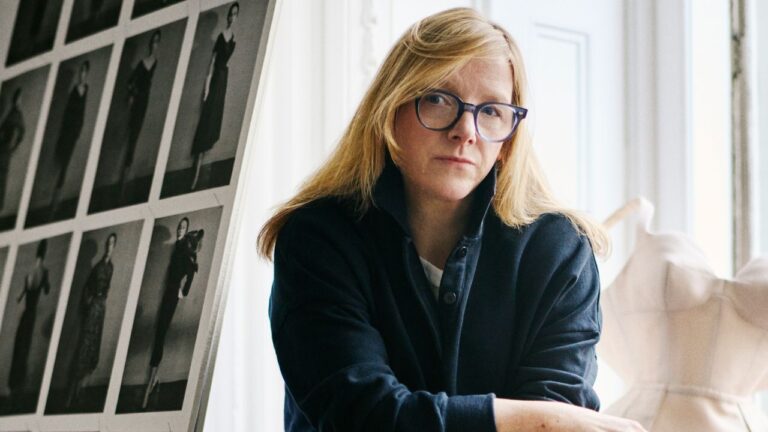And so Burton has opted to go back to the beginning – to Hubert de Givenchy’s first show in 1952. Studying black-and-white photographs of his debut, which was held in a hôtel particulier on rue Alfred de Vigny, christened by a journalist at the time “the Cathédrale”, she was struck by Givenchy’s youth – he was just 25 – and by the obvious camaraderie between the couturier and his models, among them Bettina Graziani, who also worked in his press office. “But what really amazed me,” Burton says, “was how graphic the collection was; it’s very stripped back, not fussy. For me, Givenchy – it is silhouette.”
Quite serendipitously, during a renovation of that hôtel particulier, a stash of trash bags containing archival patterns from Givenchy’s first collection were discovered inside a wall – “like a gift,” Burton says. She has one of them on display in her light-strewn office; it sits on a table opposite a large window that frames the Eiffel Tower, the kind of view that Parisians take for granted, but can stop a visitor in her tracks. But there’s no one-to-one correspondence between the treasure trove of old patterns and what you’ll see on the runway tomorrow. “I haven’t used them and made them again; I think you have to go back, but you also have to go forward. But I love the idea that they exist; they’re kind of a magical thing,” Burton says.
The patterns, which are now in the process of being restored, confirmed for her that, despite his famous association with Audrey Hepburn and Breakfast at Tiffany’s, Givenchy didn’t begin with ruffles and bows and lace. “It started quite clean, quite pure and, not back-to-basics, but it’s obviously post-war,” says Burton. “There’s a kind of simplicity.”
Where Givenchy had Hepburn, Burton has Cate Blanchett and Rooney Mara and her longtime stylist Camilla Nickerson, who wears her McQueen pantsuits like a kind of uniform. Cut – finding the shoulder, the waist, the pant shape that will define her Givenchy, down to the seams – has been Burton’s top priority since her arrival. During her time off between jobs she rented a small studio in London where she sketched, sewed and got back to “understanding why you did it all at the beginning.” Here at Givenchy, she began by sketching before moving into the atelier to drape with the team.


